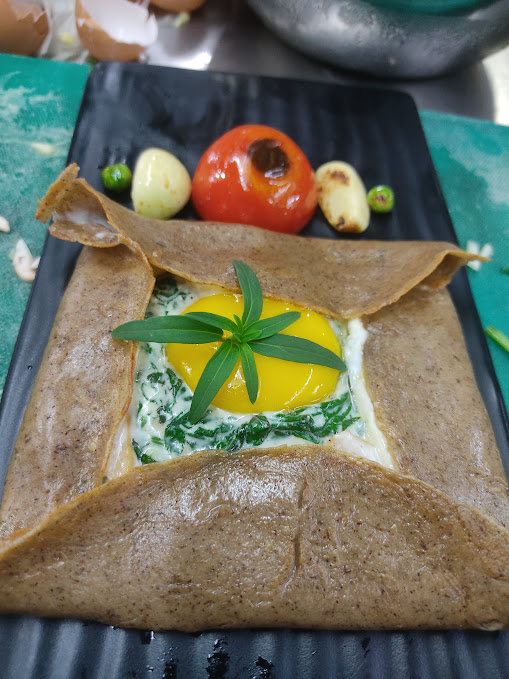Nepal’s Hidden Gem and Future Staple: Kodo Millet
Kodo millet, also known as Paspalum scrobiculatum, holds a special place in Nepal's agricultural and cultural heritage. Often overshadowed by more common grains, kodo millet has been a resilient crop that played a crucial role in the diet of the Himalayan

Historical Significance
Kodo millet has been a staple in Nepal for centuries, deeply embedded in the agricultural practices of the region. It was a crucial part of the diet for the people living in the Himalayan foothills and central ranges, providing them with the necessary energy and nutrients to endure the harsh climates and demanding physical activities. This grain contributed to the diet of the Gurkha warriors, who were known for their bravery and endurance. The high fiber content and balanced carbohydrates in kodo millet played a role in their renowned strength and resilience.
Interestingly, while kodo millet has been a long-standing crop in Nepal, other staples like potatoes and corn were introduced much later. Potatoes were introduced by the British through the Rana regime in the 19th century, and corn arrived around the same period. Both crops have since become integral to Nepali cuisine, but kodo millet remains a unique part of the country's agricultural identity.
Nutritional Value of Kodo Millet
Kodo millet is not just a resilient crop but also a nutritional powerhouse. It is rich in fiber, which aids in digestion and helps maintain a healthy gut. The grain is also packed with essential minerals such as iron, magnesium, and phosphorus, contributing to overall well-being. Additionally, kodo millet has a low glycemic index, making it an excellent choice for those managing diabetes. Its balanced carbohydrate content provides sustained energy release, preventing spikes in blood sugar levels.
Nutritional composition per 100 grams of kodo millet:
- Calories: 309 kcal
- Carbohydrates: 65.9 g
- Protein: 8.3 g
- Fat: 1.4 g
- Fiber: 5.2 g
- Iron: 1.7 mg
- Magnesium: 91 mg
- Phosphorus: 188 mg
- Calcium: 27 mg
Changing Perceptions
For many years, kodo millet was considered a "poor man's grain" due to its association with subsistence farming and its use by those who could not afford more popular grains like rice and wheat. However, the perception of kodo millet has changed significantly in recent years. With the growing interest in sustainable and resilient crops, kodo millet is gaining recognition for its ability to thrive in less water and poor soil conditions. This makes it an ideal crop for regions facing water scarcity and challenging farming environments.
As the world faces increasing water shortages, the importance of crops like kodo millet cannot be overstated. Unlike rice and wheat, which require substantial water for cultivation, kodo millet is a drought-resistant crop that can yield good harvests with minimal water. This resilience makes it a promising candidate for future agricultural practices, especially in arid and semi-arid regions.
In 2023, kodo millet received global recognition when the year was celebrated as the "Year of Millets." This initiative aimed to promote the cultivation and consumption of millets, highlighting their nutritional benefits and environmental sustainability. Kodo millet, with its rich history and promising future, stood out as a crop of significant value.
Kodo Millet Brownie with Jaggery
Embracing the rich tradition of kodo millet while adding a modern twist, here’s a delightful recipe for kodo millet brownies sweetened with jaggery.
Instructions
- 1 cup kodo millet flour
- 1/2 cup jaggery, grated
- 1/2 cup cocoa powder
- 1/4 cup butter
- 1/2 cup yogurt
- 1/2 tsp baking soda
- 1/4 tsp salt
- 1 tsp vanilla extract
- 1/4 cup chopped nuts (optional)
Instructions
1. Preheat your oven to 350°F (175°C). Grease a baking dish and set it aside.
2. In a mixing bowl, combine the kodo millet flour, cocoa powder, baking soda, and salt.
3. In another bowl, whisk together the grated jaggery and butter until smooth. Add in the yogurt and vanilla extract, mixing well.
4. Gradually add the dry ingredients to the wet mixture, stirring until just combined. If using, fold in the chopped nuts.
5. Pour the batter into the prepared baking dish, spreading it evenly.
6. Bake for 25-30 minutes, or until a toothpick inserted into the center comes out clean.
7. Allow the brownies to cool in the pan before cutting them into squares.
Enjoy these nutritious and delicious kodo millet brownies as a perfect blend of tradition and modern taste!
Kodo Millet Crepes with Spinach and Egg

For a savory twist, here’s a recipe for kodo millet crepes filled with spinach and eggs, providing a nutritious and satisfying meal.
**Ingredients:**
- 1 cup kodo millet flour
- 1/4 cup all-purpose flour
- 2 large eggs
- 1 1/2 cups milk
- 1/4 tsp salt
- 2 tbsp butter, melted
- 1 cup fresh spinach, chopped
- 1/2 cup cheese, grated (optional)
- Salt and pepper to taste
Instructions
1. In a large mixing bowl, whisk together the kodo millet flour, all-purpose flour, and salt.
2. In another bowl, beat the eggs and add the milk. Gradually add the wet ingredients to the dry mixture, whisking until smooth. Stir in the melted butter.
3. Let the batter rest for 20-30 minutes.
4. Heat a non-stick skillet over medium heat and lightly grease it with butter. Pour a small amount of batter into the skillet and swirl to spread it evenly into a thin layer.
5. Cook for 1-2 minutes until the edges start to lift, then flip and cook for another minute on the other side. Repeat with the remaining batter.
6. In a separate pan, sauté the chopped spinach until wilted. Season with salt and pepper.
7. To assemble, place a spoonful of sautéed spinach and a bit of cheese (if using) on each crepe. Fold or roll the crepes and top with a fried or poached egg.
These kodo millet crepes make for a hearty and nutritious meal, perfect for breakfast or brunch.
Kodo millet's journey from a staple of the past to a promising crop of the future reflects the resilience and adaptability of Nepalese agriculture. By embracing and promoting kodo millet, we honor our heritage while paving the way for a sustainable and nutritious future.


